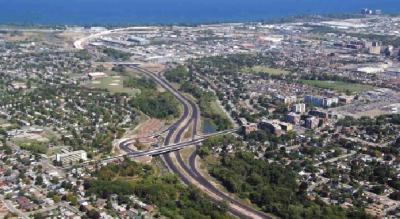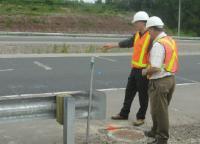
Features
Projects
Roads & Paving
‘Perpetual’ pavement helps Hamilton meet goals for Red Hill Valley Project
Perpetual pavement meets city goal
January 2, 2009 By Gary Moore and Ludomir Uzarowski
Perpetual’ pavement, with much longer-than-usual design life (50
years), is helping the City of Hamilton meet its sustainability
priorities regarding the Red Hill Valley Parkway (RHVP).

|
|
| The Red Hill Valley Parkway (RHVP) is an eight-kilometre, four-lane controlled access highway forming the north-south leg of the link between Highway 403 and the Queen Elizabeth Way.
|
Perpetual’ pavement, with much longer-than-usual design life (50 years), is helping the City of Hamilton meet its sustainability priorities regarding the Red Hill Valley Parkway (RHVP). This eight-kilometre, four-lane controlled access highway forms the north-south leg of the link between Highway 403 and the Queen Elizabeth Way. This highway is expected to see some 100,000 vehicles per day, and is projected to sustain 30 million Equivalent Single Axle Loads (ESALs) over a 20-year period and about 90 million ESALs over 50 years.
The life-cycle cost of the perpetual pavement alternative was significantly lower than that of the conventional deep strength pavement although the initial construction cost was somewhat higher. To understand why the lower life-cycle cost of perpetual pavement was important for the City, some background on the RHVP is in order.
Providing reliable, efficient transportation links is a priority for the City of Hamilton as it seeks to protect and build its employment base. At the same time, the city needs to be seen as ‘liveable’ with plenty of green space and measures to protect the natural environment.
These two potentially conflicting needs had to be met in plans for the Red Hill Valley, which runs through the city from the top of the Niagara Escarpment down to Lake Ontario. A decade-long process has seen the revitalization of the Valley, including realignment of Red Hill Creek running through the valley to improve it as aquatic-species habitat, stormwater management measures and a landscape management plan including improved nature trails.
Because of the many stakeholders involved, including environmentalist groups and industrial corporations, the project attracted considerable scrutiny. The City was under pressure to make the entire Project as sustainable as possible.

|
|
| Co-author Ludomir Uzarowski shows Golder Associates colleague Jorge Costa the design of the pavement performance monitoring system being used to measure pavement response on the Red Hill Valley Parkway in Hamilton ON. Image courtesy of Golder Associates Ltd.
|
The perpetual case
The choice of paving technology was a significant part of helping the RHVP meet its sustainability goals.
One of the priorities was to limit the amount of time that the highway had to be obstructed by construction equipment carrying out any rehabilitation work. Minimizing traffic disruption would help reduce the need for vehicles to navigate the stop-and-go traffic that is an inevitable part of highway construction done at peak drive times. This is particularly important on the RHVP because it is the only practical highway link in that part of the city between the top of the escarpment and the QEW.
Avoiding excessive vehicle exhaust emissions stemming from construction-related stop-and-go traffic is important as well – for public health reasons and also given the environmentally-sensitive nature of the Red Hill Valley.
In this, the RHVP is like many other roadways – increasing traffic volumes means that any construction-related disruptions are more serious, putting pressure on municipal authorities and other government entities to find ways to avoid or reduce this type of disruption. Their message to road maintenance service providers is “Get in – get out quickly – and stay out!”
Another sustainability-related advantage is environmental, as the RHVP pavement is an efficient traffic carrier, and in this way reducing the greenhouse gas and other emissions from vehicles.
Meeting today’s needs
Most flexible (asphalt) pavements are designed to last 20 years, and the typical life cycle involves a program of routine maintenance with a major rehabilitation every 18 to 25 years. Perpetual pavement has a design life of 50 years, so that there is no need for major rehabilitation.
The idea of longer-lasting pavement is not new. Challenges have included the engineer’s natural tendency to over-engineer when in doubt, which can mean significantly higher cost. It has been hard to tell how much is enough – limiting the results of vehicle wear-and-tear to the upper layer without putting the cost up prohibitively.
Recent studies have focused on finding that happy medium, and also on designing the multiple layers so that they perform optimally.
Unlike most engineering structures, when roads fail they do not do so catastrophically. Rather, under-design, under-construction or poor materials mean gradual deterioration until they reach a point where motorists notice the problem. Then, the phone calls, e-mails and letters may start to arrive for municipal councillors and staff.
Getting ahead of the game by carrying out maintenance before the flood of complaints can go a long way to preserving good relations with the general public.
Perpetual Pavement, which is one possible solution to the road-maintenance issue, has been made possible by a basket of technologies and materials.
One of these is Superpave (Superior Performing Asphalt Pavements), which represents a new, better system for selecting the components of hot-mix asphalt including performance graded asphalt cement, mix design and analysis, and asphalt pavement performance prediction.
Another is the sophisticated analytical capability that allows complex, multi-layer pavement systems to be accurately modeled and analyzed. The ability of laboratory testing of mechanistic properties of asphalt mixes (modulus, resistance to rutting and fatigue endurance) allows the selection and design of mixes that will sustain traffic loading over an extended period of time.
Pavement response to loading is based on physics. Knowing strains, stresses and deflections at critical points in the pavement structure, pavements can be designed against the expected types of distresses by choosing the right types of materials and layer thicknesses.
By designing the pavement structure to keep critical strains and stresses below critical values, pavements will not be subject to structural failure. Instead of deep-seated structural distresses that work their way to the surface, the wear and tear due to vehicle loading is confined to the surface. Milling the surface and replacing the asphalt deals with minor cracks before they have a chance to become serious and go deeper.
Because this work is generally straightforward, it does not take long and the job can often be done through single lane closures and at night, between evening and morning drive times. Instead of being confronted with multiple days of delays and traffic snarls, commuters are able to drive on a new road surface the next morning. This benefit was
significant for the City of Hamilton in the case of the RHVP.
For proof that pavements really can last 50 years, consider the Don Valley Parkway in Toronto. Since its construction in 1957, this roadway has only had two thin surface replacements despite current traffic levels of 100,000 vehicles per day. The City of
Toronto was recognized by the Asphalt Pavement Alliance in 2003 through the first Perpetual Pavement award to a Canadian municipal owner.
Perpetual Pavement, because it often costs more initially than the standard, 20-year configuration, often requires some “selling” based on benefits. Life cycle analysis can help demonstrate those benefits. So can monitoring the performance of existing pavement, something that the City of Hamilton is carrying out on the RHVP. The perpetual pavement performance monitoring station includes traffic monitoring and pavement response systems.
As experience with Permanent Pavement grows, the body of knowledge about its performance and advantages will become greater. Given the sustainability imperatives being placed on municipalities and other levels of governments, it seems to be an idea whose time has come.
Gary Moore, P.Eng., is the Director of Engineering Services for the Capital Planning and Implementation Division of the Public Works Department for the City of Hamilton. Contact: 905.546.2424 ext 2382; gary.moore@hamilton.ca.
Ludomir Uzarowski, Ph.D. (Pavement Engineering, University of Waterloo), P.Eng. is an Associate with Golder Associates Ltd., based in the company’s Whitby and Mississauga ON offices. Contact: 905.567.4444; luzarowski@golder.com. n
Print this page